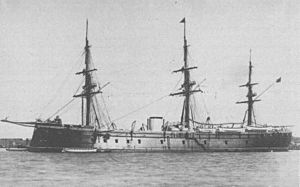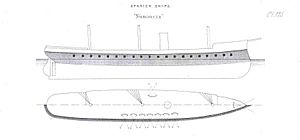Spanish ironclad Numancia facts for kids

Numancia at anchor
|
|
Quick facts for kids History |
|
|---|---|
| Name | Numancia |
| Namesake | Siege of Numantia |
| Builder | Forges et Chantiers de la Méditerranée, La Seyne, France |
| Laid down | 22 January 1861 |
| Launched | 19 November 1863 |
| Commissioned | 17 December 1864 |
| Refit | 1896–1898 |
| Stricken | 1912 |
| Fate | Sank while under tow, 17 December 1916 |
| General characteristics (as built) | |
| Type | Broadside ironclad |
| Displacement | 7,305 t (7,190 long tons) |
| Length | 95.6 m (313 ft 8 in) |
| Beam | 17.3 m (56 ft 9 in) |
| Draft | 7.7 m (25 ft) |
| Installed power | |
| Propulsion | 1 shaft, 1 horizontal-return connecting-rod steam engines |
| Sail plan | Ship rig |
| Speed | 12.7 knots (23.5 km/h; 14.6 mph) |
| Range | 3,000 nautical miles (5,600 km; 3,500 mi) at 10 knots (19 km/h; 12 mph) |
| Complement | 561 |
| Armament | 40 × 68-pounder (203 mm) smoothbore guns |
| Armor |
|
The Spanish ironclad Numancia was a powerful armored ship. Spain bought her from France in the 1860s for the Royal Spanish Navy. Her name came from the Siege of Numantia, where people bravely fought against the Roman Empire. Numancia made history by becoming the first ironclad warship to sail all the way around the Earth. She also took part in important events like the Chincha Islands War and the Cantonal Revolution.
Contents
Ship Design and Features
The Numancia was a large ship, measuring about 95.6 meters (313 feet) long. She was 17.3 meters (56 feet) wide and sat 7.7 meters (25 feet) deep in the water. The ship weighed about 7,305 tonnes (7,190 long tons). She also had a strong ram at her front, designed for attacking other ships. A crew of 561 officers and sailors worked on board.
How Numancia Moved
The ship had two steam engines that turned a single propeller. Eight large boilers created the steam needed for the engines. These engines produced about 3,700 horsepower, allowing Numancia to reach a top speed of 12.7 knots (about 23.5 kilometers per hour or 14.6 miles per hour). She could travel about 3,000 nautical miles (5,600 kilometers or 3,500 miles) at a speed of 10 knots. Besides her engines, Numancia also had three masts with sails, like a traditional sailing ship.
Ship's Weapons and Protection
When first built, Numancia had 40 large 200 mm (8-inch) guns mounted along her sides. These were smoothbore guns, meaning the inside of the barrel was smooth.
Over time, her weapons were updated:
- Around 1867, she received six 229 mm (9-inch) and three 200 mm (8-inch) Armstrong-Whitworth guns. She also got eight 160 mm (6.3-inch) Trubia guns. These new guns were "rifled muzzle-loading" (RML), meaning they had grooves inside the barrel to make shells spin and fly straighter.
- In 1883, her main guns were changed again to eight 254 mm (10-inch) Armstrong-Whitworth RML guns and seven 200 mm (8-inch) RML guns.
- During a major update in France between 1896 and 1898, she was fitted with six 160 mm (6.3-inch) Hontoria guns and eight 140 mm (5.5-inch) Canet guns. These were "rifled breech-loading" (RBL) guns, which were loaded from the back of the barrel. She also received two 354 mm (14-inch) torpedo tubes.
To protect the ship, Numancia had a strong belt of wrought iron armor around her waterline. This armor was between 100 and 130 mm (3.9 to 5.1 inches) thick. Above this belt, her guns were protected by 120 mm (4.7 inches) thick armor plates. The ship's deck, however, did not have armor.
Numancia's History and Service
In 1866, Numancia became a key ship in a Spanish fleet sent to the Pacific Ocean. She took part in the Chincha Islands War, where she shelled the cities of Valparaíso and Callao. On her journey back to Spain, Numancia achieved a major milestone: she became the first ironclad warship to sail all the way around the world.
Incidents and Later Years
On October 19, 1873, during a time of political unrest known as the Cantonal Revolution, Numancia accidentally crashed into and sank the gunboat Fernando el Católico.
In November 1902, Numancia was sent to Ceuta to help protect Spanish citizens in Morocco during a period of trouble there.
On August 5, 1911, a group of sailors on Numancia started a mutiny while the ship was in Tangiers. The mutineers were quickly stopped and put in chains. The ship then sailed to Cadiz. There, 26 of the mutineers were put on trial. They were found guilty and faced severe consequences.
Numancia was eventually taken out of service and was being towed to Bilbao to be broken up for scrap. However, on December 17, 1916, during a strong storm, she ran aground near Sesimbra, Portugal, and sank.
See also
 In Spanish: Numancia (1864) para niños
In Spanish: Numancia (1864) para niños


